Bespoken Word: Downcountry upstarts
If we don’t like ‘downcountry’ as a phrase, should we just reclassify the latest, over-achieving XC bikes as trail bikes? Guy Kesteven gets his elbows out to argue the case for a big shakeup in how we categorize the sport of mountain biking
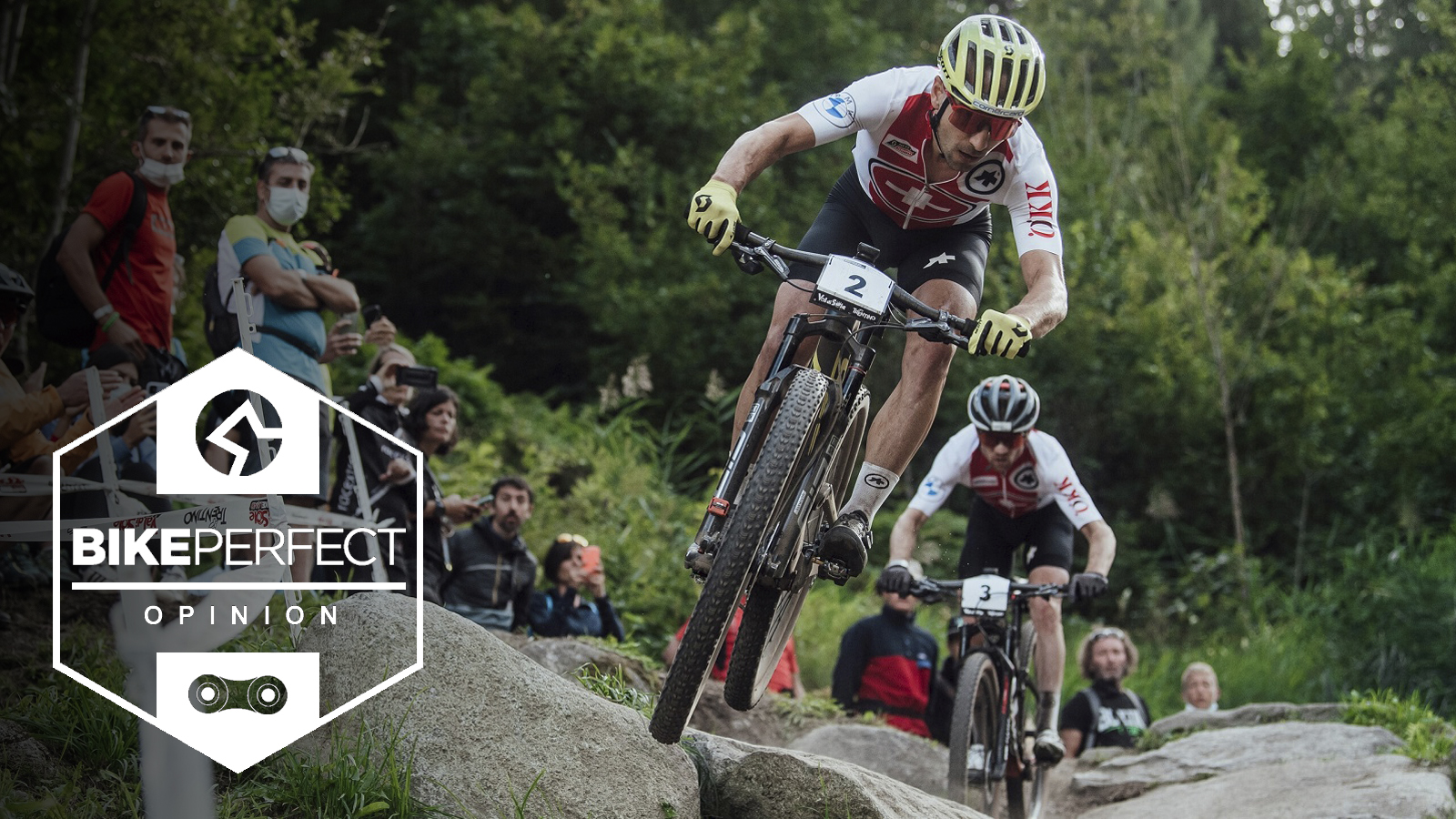
Have you watched cross-country mountain biking recently? I mean really watched it? Okay, the Snowshoe XCO World Cup last weekend wasn’t the best example, as (unlike the DH) the course was probably the tamest of the year. But for the rest of the year, the skinsuit and scary fitness gang have been SENDING IT.
I’m not just talking about that controversial big ‘ramped or not’ boulder drop that dominated the Tokyo Olympic Games coverage. You know the one that took out Mathieu Van Der Poel and levelled up Jolanda Neff’s legendary bike handler status even further when she somehow saved a ‘racing incident’ nosedive off it. For a start that was actually one of the simpler ‘one-trick pony’ sections of an almost caricature boulder-infested Japanese take on the increasingly technical nature of XC courses.
Without even rolling back through race coverage I can remember there was a massive downslope gap at Lenzerheide that both women’s and men’s fields just casually flew across without seeming to register. And they did it wearing road helmets and lycra, while most riders I know — me included — would have looked seriously from inside one of the best full-face mountain bike helmets as their knee pads knocked together. Then there’s a whole parade of rock spines, horrible vertical turns into minimal runouts, four-cross and rhythm jump sections, and random root spreads buried in dust or slick with rain, waiting on every World Cup XC circuit now.
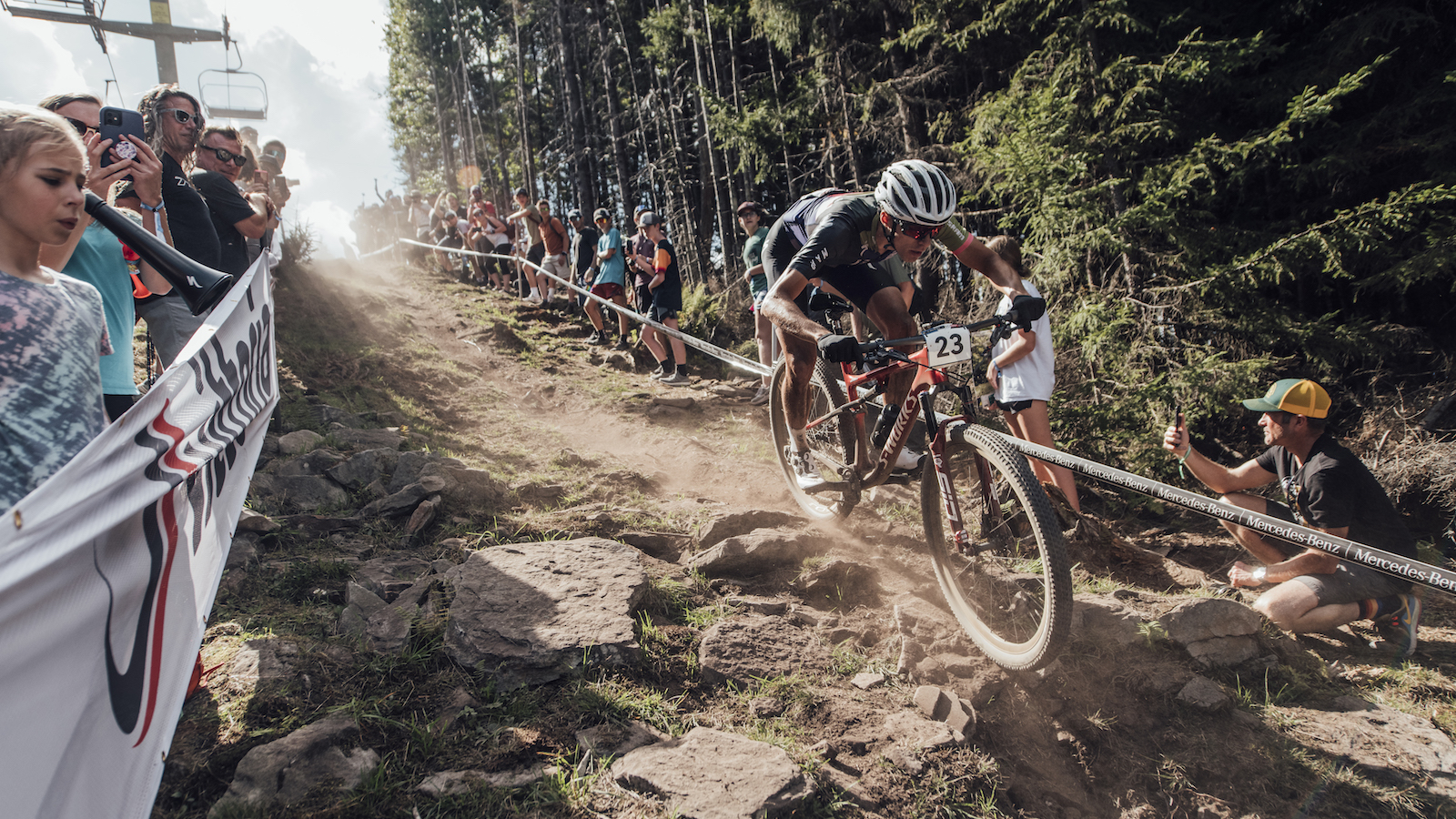
Super technical trails, super capable bikes
And while these repeated bouts of serious, sketchy, technical treachery are strung together with other sections that look comparatively simple, you’ve got to remember that even those flat, dusty grass corners are taken absolutely flat out. Not, “Ooooft I’m getting a sweat on, I shouldn’t have had that extra burger” ‘flat out’, but heart-hammering, legs-screaming, lung-burning, tunnel-vision, thought-blurring, forearm-bursting, frenzied FLAT OUT. For over an hour. Not a handful of minutes like a DH race, or an ‘epic’ enduro stage that lasts nearly 15 minutes. Over an hour. 70 minutes-plus of relentless physical pressure where lactic acid also mixes with the extreme emotions of exhaustion, euphoria or broken, deep-dive self-doubt disappointment to create a hideously toxic brew for all but the racer who gets to raise their arms at the end.
And we’re not talking about tackling these challenges with the luxury of a respectful, healthy, red-flagged gap between them and the next racer either. But in a pack of athletic apex predators. Racers who’ll dive into the slightest hint of a gap or safety margin another rider leaves, because taking that inside line could be the route to a World Championship jersey just like it was for Nino Schurter this season, or Kulhavy back at the London Olympics. Maybe in the red heat of competition, they’ll even tap a brake just before a boulder drop or back off just enough watts to stall the rider behind them right on top of one of those rock spines. In short, XCO is now the most savage, sustained environment anywhere in mountain biking right now and, because of that, the bikes have changed into incredibly capable machines a lot more people should be interested in.
Whether you like the phrase or not — to be honest I’m not sure why it upsets people so much — downcountry bikes have been around for a while, but it’s really hit its stride now. Specialized’s bigger-tire, longer-travel, proper cockpit ‘Evo’ twist on the previously uptight auto-shock Epic race bike has been a deserved smash hit. Mondraker and Santa Cruz have been offering longer travel, trail kit versions of their Podium and Blur XC bikes respectively for a while, too, and Scott can be credited not only with originating progressive XC as a category but also taking it to the next level. That’s because the Spark has actually been shaped like a trail bike (it’s consistently shared almost identical geometry with Santa Cruz’s Solo/5010 until the last update) since it was introduced almost two decades ago.
But now Scott has fully committed to the 120mm travel version for racing, rather than always offering a shorter travel option for ‘serious’ racers. And when that’s a move prompted by the development work and stopwatch testing of probably the most ‘serious’ rider ever — nine-time World Champion Nino Schurter — you know they’ve made that decision because it’s faster.
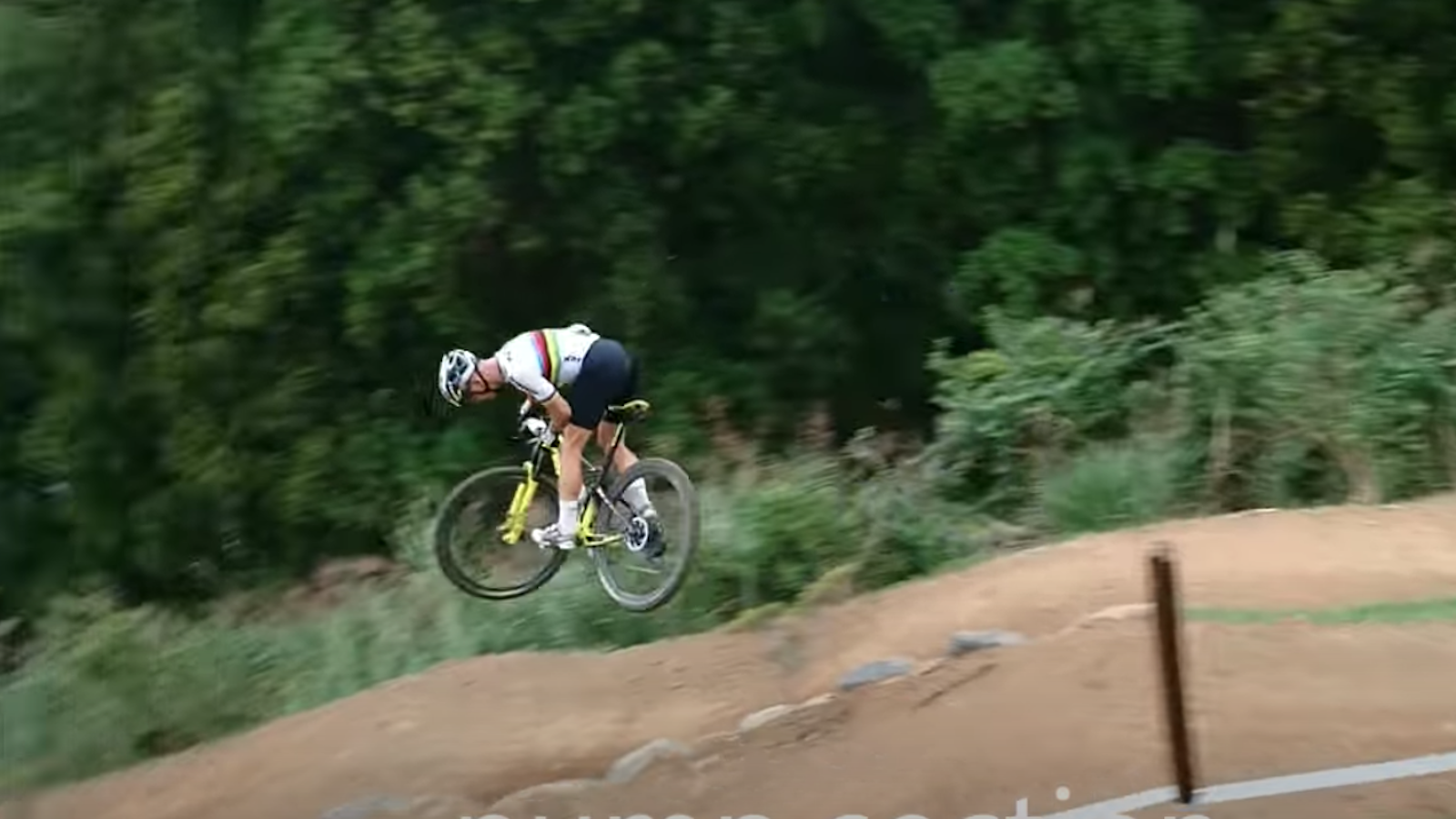
The Nino effect
Schurter was also one of the first riders to run 2.4in wide tires for their increased traction and roll-over efficiency, and while he doesn’t always use one, the best dropper posts are everywhere in the race pack nowadays.
Going back to geometry, head angles starting with seven are now pretty much extinct, even on XC start lines, and while some ‘long and stable’ XC bikes are still pretty compact in the grand scheme of things, 460mm reach bikes are increasingly common. Properly stretched frames like the Whyte S-120, NS Synonym, and Transition Spur are hopefully shining a confidence-boosting evolutionary light for others to follow, too.
The equipment being fitted to these bikes is brilliant as well. We’ve already mentioned the appearance of properly light and fast large-volume tires, but there are now really wide-rimmed wheelsets for them to sit on that weigh 500-800g less than enduro wheels. I don’t know anyone who hasn’t ridden a RockShox SID SL Ultimate fork and not been totally blown away with what the 120mm stroke and 35mm legs can take in their stride, and "120 is plenty” at the back, as long as the engineers have done their homework properly. That even includes flex stay rather than pivoted rear ends, and leaving out some bearings also makes the bike a couple of hundred grams lighter on the way to a total frame weight that’s often a kilo lower than the same brand’s 130mm bike.
It’s once the whole bike has been built up that things are really significant though. Because we’re now expecting the best trail bikes with 130-140mm travel to brawl as hard (or maybe even harder given their ‘with pop and play that’s appreciated by the most skilled and aggressive riders’ remit), manufacturers now tend to load up their mid-travel bikes as though they’re about to tackle the Mountain of Hell race. Using 2.5in high-grip tires with a reinforced carcass on the rear at least, not to mention overbuilt frames to cope with off-piste abuse with under-stroke suspension, 170mm long dropper posts, and seriously heavy-duty wheels. It’s no wonder most trail bikes weigh 14-15kg plus, whatever their travel. And that’s the kind of sluggish, climb-extending weight and drag that makes putting a battery and a motor on the ‘must have’ list for your next bike really appealing.
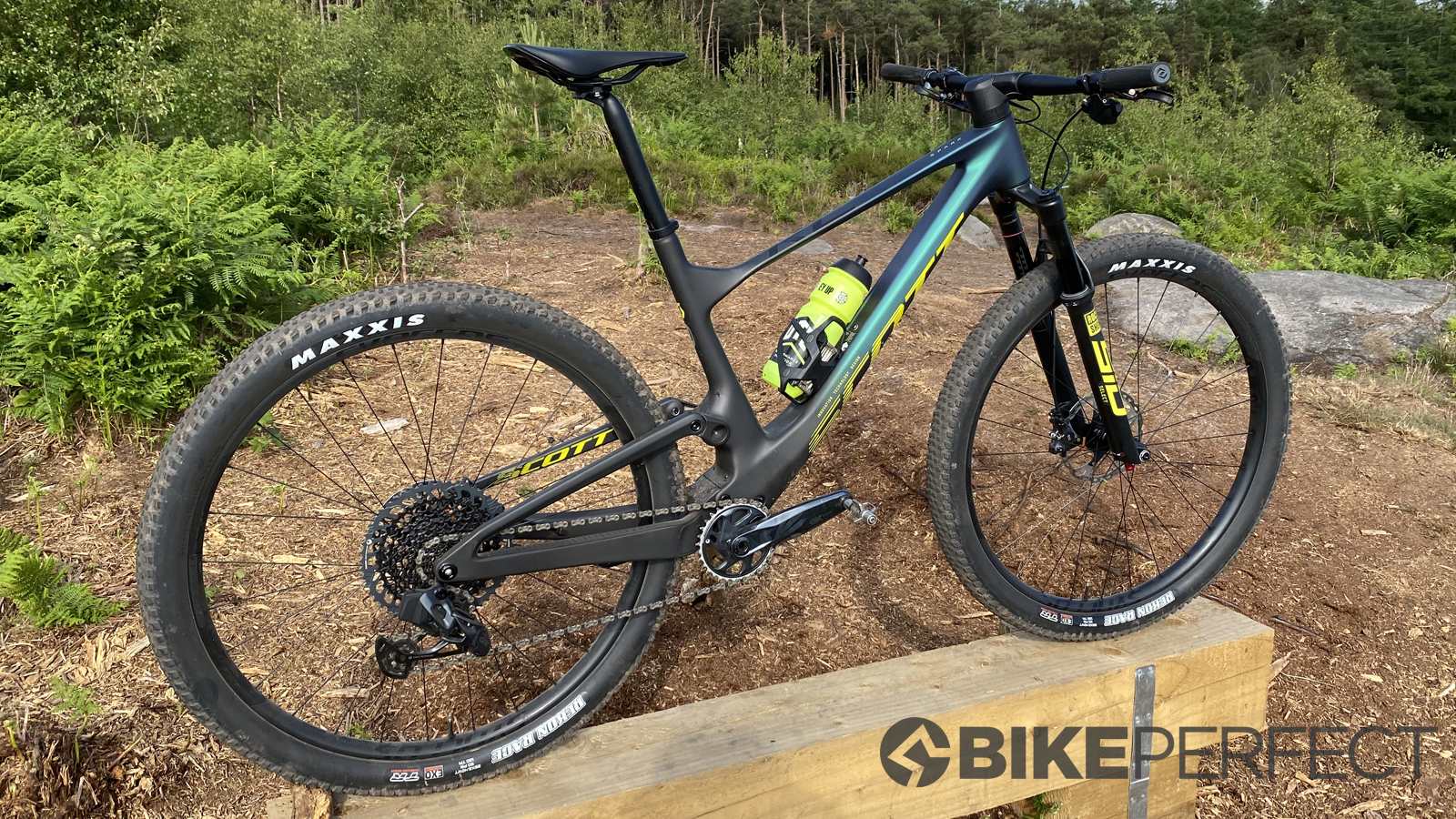
A do-it-all machine
Contrast that with the ridiculous, euphoric joy of pressing hard on the pedals of a 10-11kg full-suspension bike with a taut power response and blissfully fast-rolling tires. Seeing the summit of a climb rush towards you in a blur as though Chewbacca has just reconnected the hyperspace, flicking off a root and properly flying for miles, not heaving with all your might off the lip and then not really knowing whether you left the ground or not because the landing is so solidly damped.
Finishing a multi-hour ride over proper hills, planning your next one even longer, and loving mountain biking even more than when you set off, rather than already writing the eBay listing for your bike in your head as you stare at that massive front tire to check it’s actually revolving.
And if you’re thinking, “but XC racers are ridiculously skilled and the bikes really aren’t suitable for rough riding” can I flick you back to the start of this piece, please. If we’re honest, for most of us, these bikes — maybe with a front tire switch for wetter days — are more than enough to handle the terrain and speeds that most of us are comfortable with. And when bike, rider, and terrain all line-up and look over the ragged edge together, that’s my personal riding sweet spot. Not apologizing to the bike for overbraking again or realizing I could have leaned that gluey front tire a lot harder or sent that piggyback shock ten times as far as my cowardice would allow without even troubling its Alp-optimized damping circuitry.
Even the last two Enduro rides I did, I ultimately regretted what seemed like the obvious bike choice for the job. Seven hours’ shepherding people around the last race of the brutally rocky, barely rideable climb-infested circuit of Ard Rock with 14 stages already in my legs from previous days was clearly a job for a heavyweight e-bike on paper. But damn, if wrestling 27kg of a coil-sprung 29 x 2.6in gravity carcass tire-shod beast around the Yorkshire Dales didn’t near ruin me.
And while trying to stay ahead of ex-World Cup-winning downhillers as Lead Out Marshall around four hours of the Ard Moors course, I was wishing I’d pulled the 10kg Blur out of the back of the van, not the 16kg+ enduro bike for 99 per cent of the way. But I’d scared myself into thinking that I needed a bike with a soft compound Nobby Nick front tire and a 150kg ‘system weight limit’ to nurse my broken rib over the two drops I was slightly concerned about, and I ended up putting myself through way more pain on the climbs and linking sections. In fact, I was almost certainly in worse shape to send either of them than I would have been on an effortless XC rig (that has a no-questions-asked lifetime warranty on both frame and wheels anyway) that I’ve spent all summer chasing bigger bikes and blasting through serious boulder sections on.
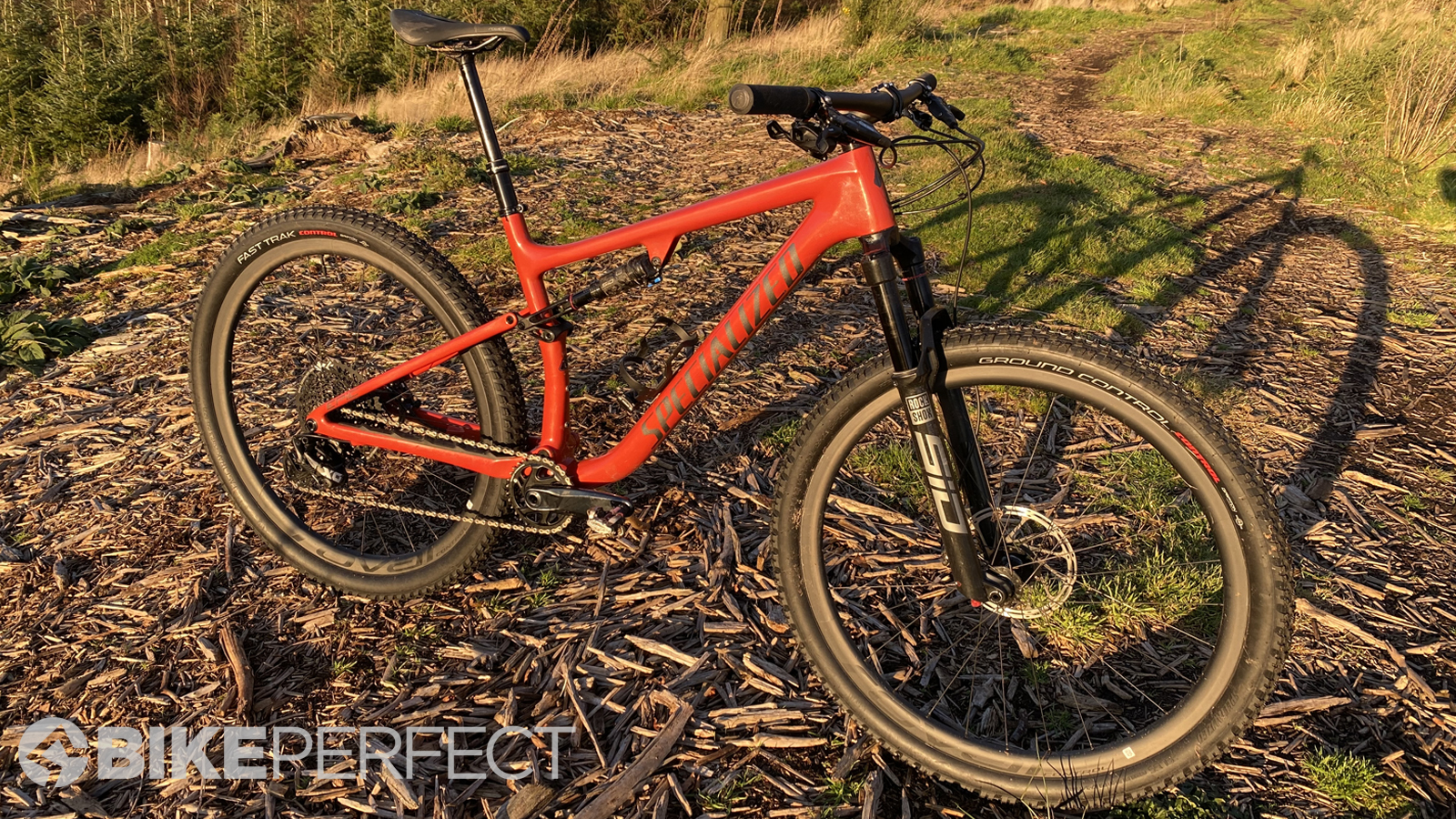
A curious case for downcountry
So maybe ‘downcountry’ is a stupid phrase not because it’s seen as a cynical marketing twist, but because we should probably just up-classify these seriously capable, but mileage-happy machines as trail bikes. After all, ‘trail bikes’ are now basically ‘enduro bikes’ and the latest, best enduro mountain bikes like the Forbidden Dreadnought and the Norco Range are only a shock change and triple crown fork away from being DH race rigs. In fact, Graham Agassiz has been riding Red Bull Rampage on his Evil Wreckoning ‘enduro bike’ for a while. That would also leave room for gravel bikes to flex their ambition to become the new version of traditional XC riding.
In turn, that would keep a place open for 70-degree head angle 29er hardtails that can’t cope with current XCO to make a comeback when people wake up to the fact that they’re actually way better for what most people are doing on gravel bikes these days. Or does that kick off another round of the ‘overbiked = underwhelming experience’ argument that got us here in the first place?
Whatever the outcome, what I’m most excited about is that even after 40 years of playing about in the dirt on a bike, our sport is still evolving in terms of expectations and the technology being created to let us exceed them again and push on to even more exciting prospects, whatever sort of riding we're into.

Guy Kesteven has been working on Bike Perfect since its launch in 2019. He started writing and testing for bike mags in 1996. Since then he’s written several million words about several thousand test bikes and a ridiculous amount of riding gear. He’s also penned a handful of bike-related books and he reviews MTBs over on YouTube.
Current rides: Cervelo ZFS-5, Specialized Chisel, custom Nicolai enduro tandem, Landescape/Swallow custom gravel tandem
Height: 180cm
Weight: 69kg
